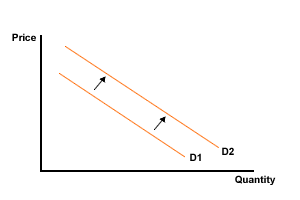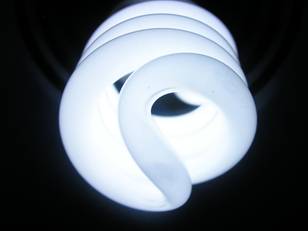Demand - short answer

Question 1
What is individual demand? Using a diagram(s) explain the relationship between individual demand and market demand
Question 2
The table below represents the market for DVD's. For each of the changes given, tick the relevant column to show whether the demand curve has shifted either left or right or whether there has been an extension or contraction of demand (a movement along the demand curve).
| Change | Shift right | Shift left | Extension in demand | Contraction in demand |
|---|---|---|---|---|
| There is an increase in real incomes | ||||
| Raw material costs increase | ||||
| New capital equipment enables DVD producers to increase productivity | ||||
| A new super CD-ROM is developed that is cheaper than DVD's but has same functionality | ||||
| A major pay per view cable provider goes into liquidation | ||||
| There is a serious recession | ||||
| Prices of DVD players fall |
Question 3

Demand curve shifting right
 Energy
saving light bulbs can be used to replace conventional light bulbs. At
present energy saving light bulbs are significantly more expensive to
buy than normal light bulbs and the light takes several minutes to
reach full intensity. If the above demand curve is the demand curve for
energy saving light bulbs, which of the following events may have
caused the shift shown?
Energy
saving light bulbs can be used to replace conventional light bulbs. At
present energy saving light bulbs are significantly more expensive to
buy than normal light bulbs and the light takes several minutes to
reach full intensity. If the above demand curve is the demand curve for
energy saving light bulbs, which of the following events may have
caused the shift shown?
(a) A fall in price of a conventional light bulbs
(b) Government legislation restricting the manufacture and sale of conventional light bulbs
(c) An increase in the cost of electricity
(d) An increase in the price of raw materials required for the manufacture of energy saving light bulbs
(e) Medical reports about cancer causing effects of energy light bulbs
(f) A decrease in real incomes
(g) An increase in real incomes
(h) A major advertising campaign showing the benefits of energy light bulbs
(i) Improved technology speeding up the time taken for energy saving light bulbs to reach full light intensity
Question 4
Which of the following would you regard as substitutes for a laptop computer and which may be complements? In each case consider whether they are 'close' complements or substitutes.
(a) Apple iPod
(b) Desktop computers
(c) PDA's
(d) Web site development software
(e) Mobile phones
(f) Handheld tablet computers
(g) Docking stations
